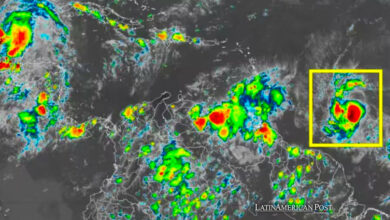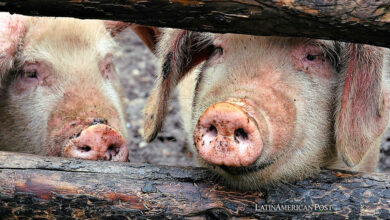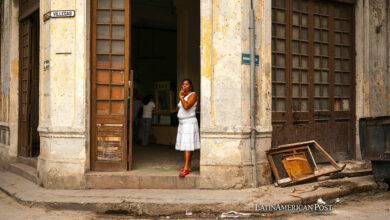Hurricane Beryl Threatens Mexico’s Quintana Roo With Severe Impact

As Hurricane Beryl, a Category 4 storm, approaches Quintana Roo’s coast, emergency services, and the general population remain on high alert, implementing prevention programs to mitigate the storm’s impact expected late Thursday night or early Friday morning.
As Hurricane Beryl, a Category 4 storm, approaches Quintana Roo’s coast, emergency services and the general population remain on high alert. They are implementing prevention programs to mitigate the storm’s expected impact late Thursday night or early Friday morning.
To address the contingency, the State Council of Civil Protection (PC) has been established in Cancún, a unified effort led by Governor Mara Lezama and National Civil Protection Coordinator Laura Velázquez. This council, which includes the Navy, Army, National Guard, and federal agencies such as the National Water Commission (Conagua), Federal Electricity Commission (CFE), and the Ministry of Infrastructure, Communications, and Transportation (SICT), is a testament to the collective determination to protect Quintana Roo.
Preparations in Quintana Roo
According to Bernardo Cueto, Secretary of Tourism in Quintana Roo, there are currently 355,786 tourists vacationing throughout the state, primarily between Cancún and the Riviera Maya, representing a 68.5% hotel occupancy rate. “We are identifying the number of tourists and the shelters available for them in various state destinations, and we will be ready to transport tourists to safe shelters if Civil Protection authorities determine evacuation is necessary,” Cueto explained.
The entire state of Quintana Roo is on yellow alert, while the municipalities of Tulum, Felipe Carrillo Puerto, Bacalar, Othon P. Banco, and José María Morelos are on orange alert. The status may change as the hurricane advances, having recently passed Jamaica and continuing through the Caribbean.
Security measures include closing ports to small vessels, suspending activities in tourist parks, halting classes at all educational levels, and enforcing a dry law, which prohibits alcohol sales during emergencies to prevent potential disorder and ensure public safety, starting early Thursday morning. Diego Castañón, the municipal president of Tulum, which is expected to receive the hurricane’s direct impact if its trajectory holds, announced the setup of 42 cyclone shelters for tourists and the general population. These shelters will be staffed with a doctor and nurse and supported by military and civil protection personnel.
Community Response and Evacuation Efforts
The fishing community of Punta Allen, located in the Sian Ka’an reserve, is one of the first to be evacuated, ensuring the safety of its residents. Those who cannot relocate with family or to other state areas will find refuge in an educational center. Castañón detailed that 22 shelters are in the Maya zone and 20 more along the coast. These shelters can accommodate up to 5,000 people and are equipped with mats, blankets, food, and medical staff to meet basic needs, providing a sense of security in the face of the impending storm.
Although Holbox Island has had no official evacuation order, Governor Lezama announced early that free boat services would be available for residents wishing to seek shelter on the mainland.
The Double Impact of Hurricane Beryl
Authorities predict that by late Thursday night or early Friday morning, the center of Hurricane Beryl, with winds reaching 220 kilometers per hour and gusts up to 270 km/h, moving west-northwest at 31 km/h, will be over the central-northern region of Quintana Roo, in Felipe Carrillo Puerto municipality. After making landfall as a Category 2 hurricane, Beryl is expected to weaken to a tropical storm by Friday night in the Gulf of Mexico before regaining strength as a Category 1 hurricane and hitting the coast of Tamaulipas on Sunday night or early Monday morning.
Félix Tornéz Martínez, a fisherman and tourist service provider in Puerto Morelos, has taken precautions by securing his boat in a baseball field alongside his fellow fishermen. “More boats need to be brought in; the baseball stadium will be filled, and they will remain here for about 5 or 6 days, maybe longer, until the authorities declare the contingency over,” he commented. “The first recommendation from the Captaincy and courses is to safeguard life and the boats. We protect them as we protect ourselves,” Tornéz explained to EFE.
Historical Context and Regional Impact
Hurricane Beryl, which has already claimed seven lives in the Caribbean islands, is the first hurricane of the season and sets an “alarming precedent,” according to the World Meteorological Organization (WMO). Never before has such an intense cyclone formed this early in the Atlantic season, the WMO warned on Tuesday.
The approach of Hurricane Beryl highlights the vulnerability of the Caribbean and Central American regions to natural disasters exacerbated by climate change. The frequency and intensity of hurricanes have increased, posing significant risks to communities, infrastructure, and economies. The response in Quintana Roo demonstrates the importance of preparedness and coordinated efforts among local, state, and federal agencies to protect lives and minimize damage.
Also read: Ancient DNA Study Sheds Light on Maya Sacrifices in Mexico’s Chichén Itzá
As Hurricane Beryl approaches Quintana Roo, the region braces for its impact with comprehensive emergency measures. The state’s proactive approach to protect its residents and tourists, including the setup of shelters and evacuation plans, reflects a strong commitment to disaster management. The cooperation between various governmental and non-governmental organizations underscores the critical need for preparedness in the face of increasingly severe weather events. This hurricane season serves as a reminder of the ongoing challenges posed by climate change and the necessity for resilient and adaptive strategies in vulnerable regions like Quintana Roo.





